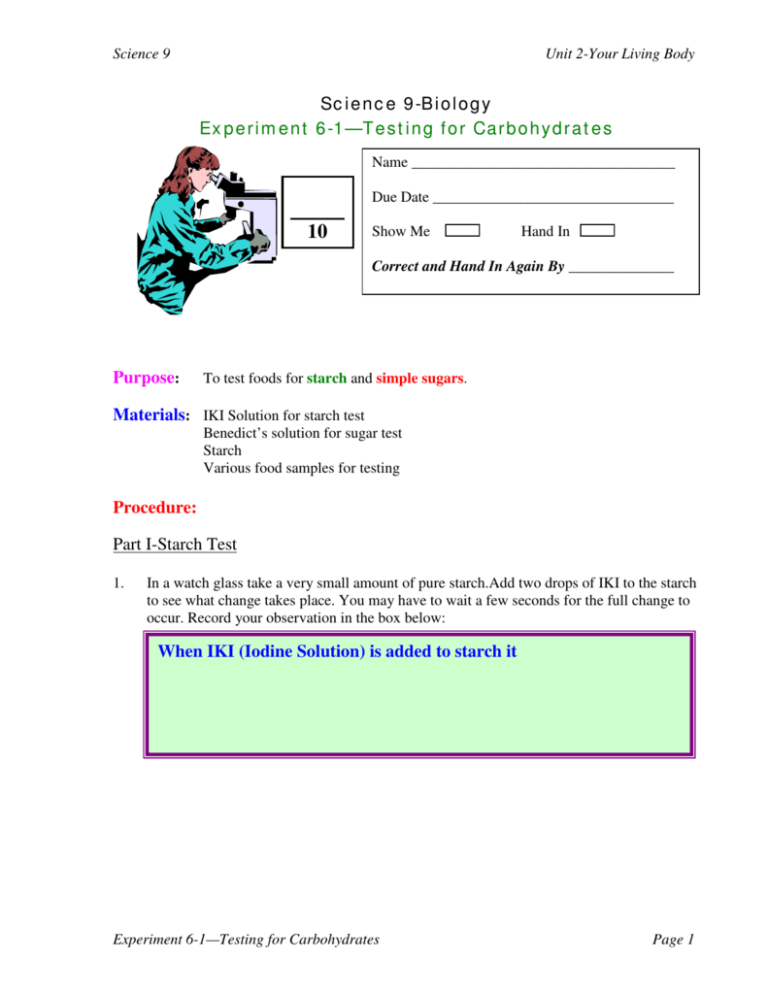Science 9-Biology Experiment 6-1—Testing for
advertisement

Science 9 Unit 2-Your Living Body Sc i e n c e 9 -B i o l o g y Ex p e r i m e n t 6 -1 —T e s t i n g f o r Ca r b o h y d r a t e s Name ___________________________________ Due Date ________________________________ 10 Show Me Hand In Correct and Hand In Again By ______________ Purpose: To test foods for starch and simple sugars. Materials: IKI Solution for starch test Benedict’s solution for sugar test Starch Various food samples for testing Procedure: Part I-Starch Test 1. In a watch glass take a very small amount of pure starch.Add two drops of IKI to the starch to see what change takes place. You may have to wait a few seconds for the full change to occur. Record your observation in the box below: When IKI (Iodine Solution) is added to starch it Experiment 6-1—Testing for Carbohydrates Page 1 Science 9 Unit 2-Your Living Body Part 2-Testing Foods for Starch 1. Get very small amounts of five different food samples and put each one into a different place on a spot plate. Select some samples that you think have starch and some you think don’t have starch. In one of the places on the spot plate, put a few drops of water. It is known that pure water does not contain starch, so this is an experimental control! Make sure you know which sample is which. 2. Write the name of each sample in the following table: 1. 2. 3. 4. 5. 6. Name of Sample Water Observations with IKI Positive Test for Starch? (Y/N) 3. Add two drops of IKI solution to each of the six samples, wait for a couple of minutes then write down the observations in the table above. 4. Compare each observation with the starch test on page 1 of this lab and decide whether the food tests positive for starch or not. Fill in the results in column 3 of the table above. Part 3-Testing Foods for Simple Sugars 1. Fill a 400 or 600 ml beaker half full of water, place it on a hotplate and bring it to a boil. Once the water boils reduce the heat. You will share a hot plate with the other group at your station. 2. Get 6 test tubes and label them 1-6. 3. Add about 2 mL of water to test tube #1. This is your experimental control. Experiment 6-1—Testing for Carbohydrates Page 2 Science 9 Unit 2-Your Living Body Get small amounts of five different food samples and add them to test tubes #2-6. In the table below, put the name of the sample beside the test tube number it corresponds to. Make sure you do this before you start Procedure 5! 4. Test tube # 1 2 3 4 5 6 Name of Sample Observations with Benedict’s Solution Positive Test for Simple Sugar? (Y/N) Water Relative Amount of Sugar (L/M/H) None 5. Add about 3 mL of water and 3 mL of Benedict’s Solution to each of the 6 test tubes and swirl it to mix it. 6. Carefully place the six test tubes into the gently boiling water bath and let them sit for 3 to 5 minutes. 7. Remove the test tubes from the hot water bath and turn off the hotplate. Place the test tubes in a rack in the order of 1Æ 6. 8. Record your observations for each sample in the table in Procedure 4 above. 9. Given that: Blue Green Brown Orange Means No Simple Sugar Means a Low Amount of Simple Sugar Means a Medium Amount of Simple Sugar Means a High Amount of Simple Sugar Decide whether each sample tests positive (Y) or negative (N) and estimate the relative amount of simple sugar in each sample (L, M or H). Write the results in the table in Procedure 4 above. 10. Clean out all the test tubes with the remaining hot water in the water bath. Use a test tube brush and soap to make sure you get the test tubes very clean! Also, clean up any mess caused by the food samples. Experiment 6-1—Testing for Carbohydrates Page 3 Science 9 Unit 2-Your Living Body Questions: 1. In order to test a food for starch, add a few drops of ________________ solution. If starch is present, the colour of the solution will turn ____________________________ If starch is NOT present, the colour of the solution will remain _____________________ 2. In order to test for simple sugars in foods, add water and ___________________________ solution. Then place the test tubes in a _________________________________________ If the solution stays ______________, it means there is no simple sugar. If the solution turns ______________, it means there is a small amount of simple sugar. If the solution turns ______________, it means there is a medium amount of simple sugar. If the solution turns ______________, it means there is a large amount of simple sugar. 3. Name a few common foods which contain starch. 4. What does the body use starch for? 5. Name a few common foods which contain simple sugars. 6. What does the body use simple sugars for? 7. What was the purpose of including a sample of water with each set of food samples in the starch and sugar tests? ______________________________________________________ Experiment 6-1—Testing for Carbohydrates Page 4









